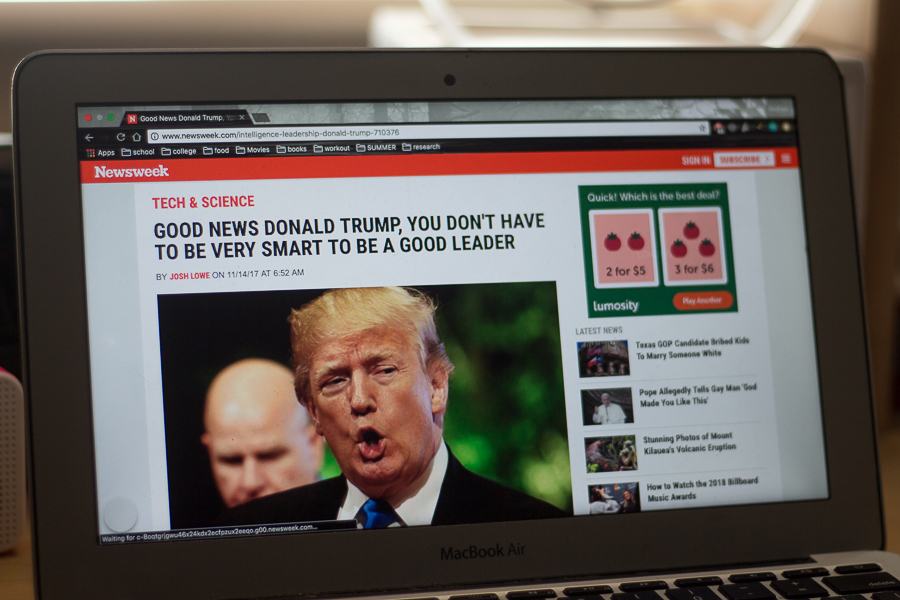
Although mostly harmless, clickbait can have negative political and social repercussions
Clickbait is one of the most pervasive and hard-to-ignore features of the Internet in the 21st century. It undoubtedly plays an important role in how people perceive the world: politically, economically, socially, racially and religiously. The early days of Internet grappled with spam — Viagra advertisements, miracle beauty cures, fake lottery wins — but today such ads encompass only a small portion of the material that Internet users are exposed to on a daily basis.
For example, when I first began using Facebook as a 15-year-old in 2014, I was puzzled by the near-constant flow of Tampax commercials, American Apparel ads, psychological horror stories, crisis hotline numbers and unsolicited beauty advice columns that were constantly appearing on my feed. Then I understood: Just as a middle-aged woman using Facebook might be exposed to ads advertising dating sites for “hot single men over 50,” my Facebook page was feeding me commercials and information that they thought I would find interesting. Aside from finding this utterly depressing — teenage girls, believe it or not, have more to think about than feminine hygiene and whether or not their summer body is bikini-ready — I also found it irritating and insulting. I was going through a particularly self-conscious phase of my life, so I’m certain that the impact of such clickbait registered much more sharply than it would now. I remember realizing that I would never really be free: someone, somewhere, would always be trying to tell me what to do, how to look, how to act. Even the Internet had it in for me.
I also noticed that my Facebook feed was providing me with a particularly apocalyptic world view. If I had decided not to use the “manage my ads” feature, I may have been inclined to fall into the negative vortex of “information” that claimed that, as a teenage girl in the 14-to-18 age group, I would likely experience unprecedented anxiety, love problems, beauty worries and reproductive crises on a near-daily basis. Evidently, womanhood was even more fraught with danger than I had anticipated. Nevertheless, I believed that in managing my ads, I would be immune to the clickbait that tailed me on social media and in my Internet searches. This, of course, is not so.
As a college student, I engage in brainless Internet surfing fairly often. It’s a way to relax, I tell myself, a way to escape the daily drudgery of the trending news cycle that haunts my iPhone day in and day out. I will even confess that, in addition to reading The New York Times and The Washington Post to assure myself that I’m still an informed, upright citizen with a balanced view of the world, I have religiously followed the details of the upcoming royal wedding. I have fallen prey to articles citing “Ten Times Meghan Markle was a Total Boss,” “Ten Times Meghan Markle and Prince Harry were Totally Cute” and “What Meghan Markle Looked Like Before She was Famous.” I can’t help it. Markle may finally be able to redeem the whole abdication-Wallis-Simpson-fiasco that shook the English monarchy to its core in the 1930s. A divorced, biracial, Catholic-school-educated American actress is marrying into the notoriously stuffy House of Windsor. Can you blame me for enjoying it? Nevertheless, I’ve begun to notice that the Markle thread is following me. Her much-sought-after Everlane bag, rumored to have “broken the Internet,” has appeared on my feed, as have endless “top ten” lists featuring beauty and fashion candids. It’s beginning to feel a little strange. It appears that I’m still, after all, a victim of clickbait.
Naturally, such articles are harmless enough. I’m old enough to distinguish between reality and fantasy, truth and nonsense — or so I tell myself. However, clickbait can still have negative repercussions. As I wrote about in my previous column, clickbait and “trending” features are not limited just to product histories. They can be political, contributing to a narrow and isolationist worldview that is becoming increasingly hard to fight in this era of social, economic and ideological polarization. They can be psychological, convincing you that you’re on the verge of a nervous breakdown, that you may benefit from Adderall. And they can be social. Here you are, sitting in your dorm room, while everyone else is out having a good time. Everyone else is more fashionable, more politically aware, than you are. Have you seen these new sneakers? Have you watched Childish Gambino’s “This is America” video? Moreover, have you finally copped on to the fact that Childish Gambino and Donald Glover are the same person? Have you registered to vote? Get with it, Rebecca.
Written by: Rebecca Bihn-Wallace — rlbihnwallace@ucdavis.edu
Disclaimer: The views and opinions expressed by individual columnists belong to the columnists alone and do not necessarily indicate the views and opinions held by The California Aggie.



